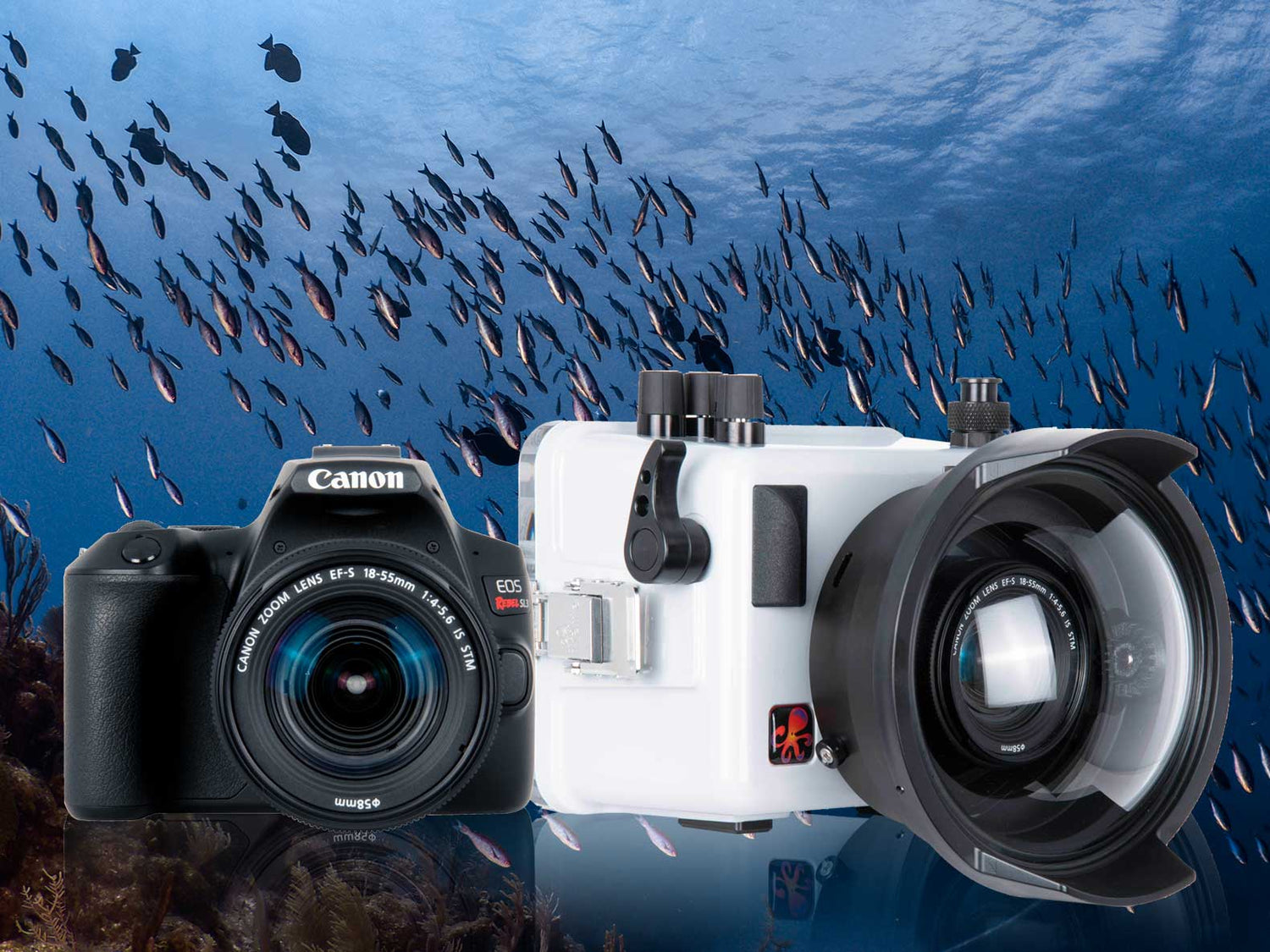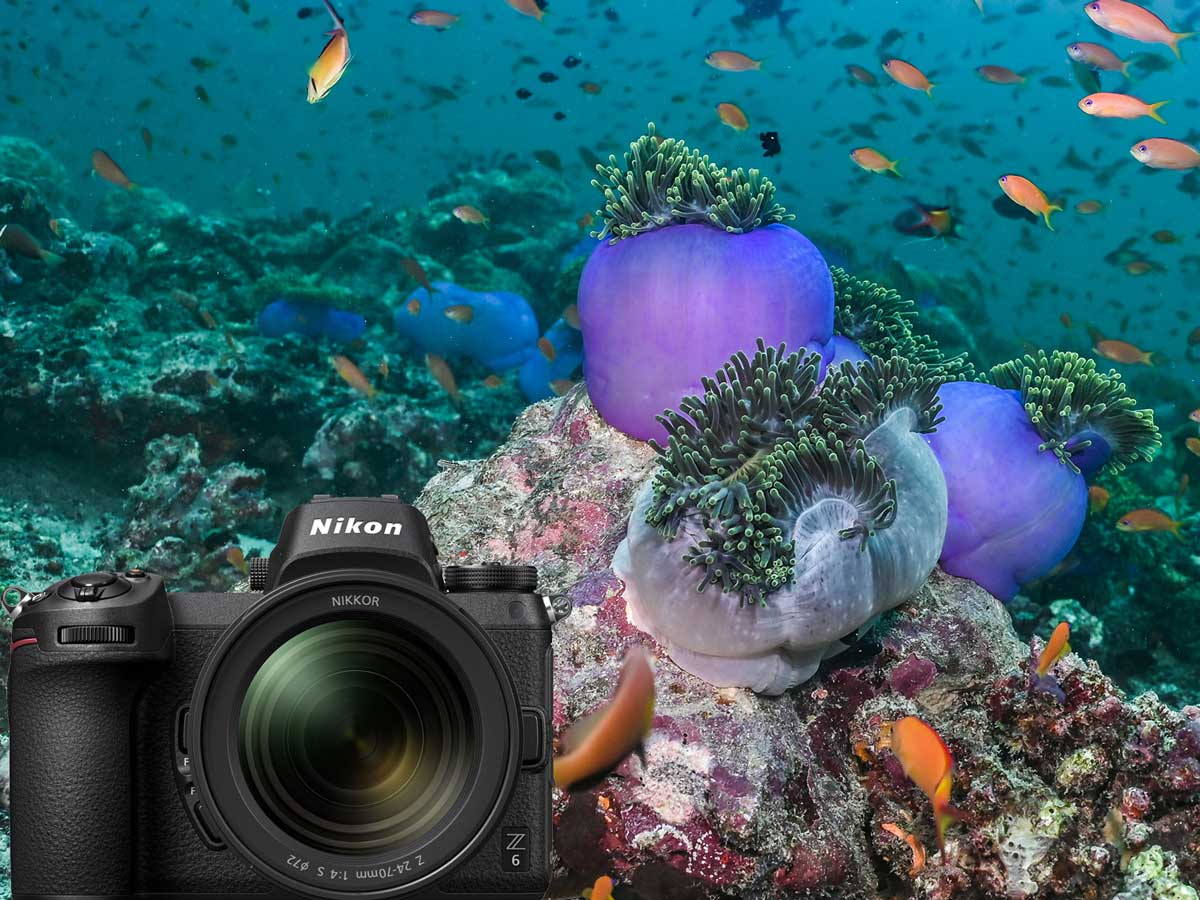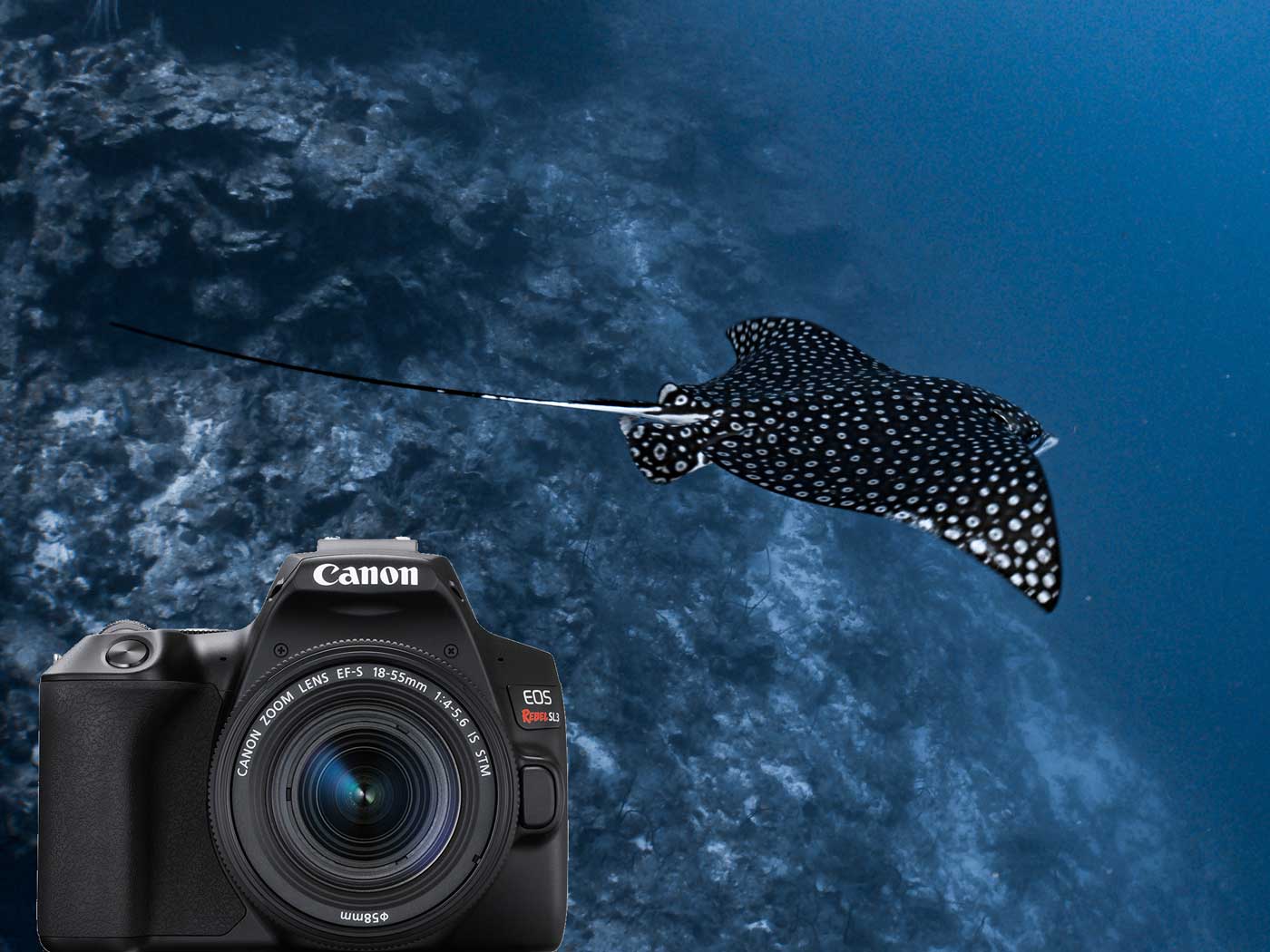By Jean Rydberg
There’s a lot to love about the newest mirrorless cameras on the market but there are also a few stumbling blocks. To get a compact system, you’re often still sacrificing significantly on battery life and lens support. For DSLR quality performance you generally have to move up to a full frame mirrorless, which means a larger system and a lot more money.
And that's exactly why we love the Canon EOS Rebel SL3 system. It embodies all of the features that we’re looking for when we just want to get out there and enjoy ourselves shooting great photos and video underwater.

Left to right: Canon EOS 5D Mark IV, Canon EOS 80D, Canon EOS Rebel T7i, Canon EOS Rebel SL3
Compact Size and Weight for Travel
Billed as the smallest and lightest EOS camera to date, the SL3 camera body is actually sized less like a traditional DSLR and more like a compact mirrorless camera. That means that it requires a much smaller housing, which is better in pretty much every respect. A smaller housing is lighter and easier to travel with. It also creates less drag underwater for better buoyancy control and reduced arm fatigue.

Our interchangeable lens ports are some of the lightest available without sacrificing on image quality. Port options are available for the best wide angle, zoom, and macro lens choices.
The Best Lenses for Underwater Shooting
Mirrorless systems still have a long way to go to catch up with the breadth and quality of the range of lenses for DSLR systems. Canon EF lenses continue to be popular due to both their performance and their prevalence. But with mirrorless camera bodies these lenses need to be attached with an adapter that can hinder (or eliminate) autofocus performance and slow down your system.
The SL3 camera has a native EF mount to accept our favorite Canon EF and EF-S lenses. Focus is fast and accurate. Here are our top picks for Canon glass:
Canon 8-15mm Fisheye
Super sharp, high quality glass for the best wide angle images and video. Since it's designed for a full frame camera it will not act like a circular fisheye on the SL3- just a super wide lens with a little bit of vignetting at 8mm. Like most cameras, the SL3 records 4K video with a crop factor of 1.6x. This effectively narrows the camera’s field of view in 4K video mode. Using an ultrawide fisheye lens helps to compensate for the crop factor.
Additional Reading: Why You Need a Fisheye Lens Underwater
Tokina 10-17mm Fisheye
Super lightweight and compact with a great wide angle focal length range. This is an affordable and fun to use combination that can focus right down to the front of the dome for great close focus wide angle.
Additional Reading: Close Focus Wide Angle In Depth
Canon 18-55mm Kit Lens
Not quite wide angle or macro, the kit lens isn’t the best lens for any particular application but it is a good lens for general photography of everything from Christmas tree worms to turtles and divers.
Canon 60mm Macro
A perfect macro solution for a crop sensor DSLR camera like the SL3. You can get closer to your subject than with a 100mm and it still provides the ability to stack external diopters for super macro. The crop factor of the camera works in your favor for shooting very small subjects.
Canon 100mm Macro
The king of underwater macro lenses and a popular choice that is already in many DSLR photographers photo bags. A 100mm gives you a little bit of slack in working distance compared to a 60mm Macro.

The "Dry Lock" port mount keeps water away from your camera's precious image sensor. It also makes lens changes quick and easy.
Lenses are installed and changed quickly using the Dry Lock Micro (DLM) port system. “Dry Lock” refers to the placement of the o-ring seal on the outer perimeter of the housing’s port mount. This keeps residual water and moisture away from your camera’s image sensor when doing lens changes. The DLM system has a super secure mount system with no complex moving parts that could jam up or break in a remote location.
TTL Strobe Exposure
Thru-the-lens (TTL) strobe metering is the gold standard for proper flash exposure. True TTL performance requires communication between the camera and the strobe through a direct connection. The camera decides how much light it needs from the strobe(s) based on distance to subject and available light.
Without TTL, you would need to reach up and change the power on each of your strobes every time that your subject moves closer or farther away. This is difficult to do quickly and accurately when shooting moving subjects, meaning you’re settling for less-than-perfect exposure most of the time.
Shooting TTL or “automatic” exposure doesn’t mean you’re giving up exposure control of your photos. Exposure control is essential underwater where light behaves differently than it does in air. The good news is that you can shoot in the camera’s Manual (M) mode while shooting your strobes in TTL for the best of both worlds.
Additional Reading: The Myth of TTL Strobe Exposure Underwater

The housing is just right sized for big or small hands. The addition of a trigger extension puts the shutter at easy reach when shooting with a dual tray and handles.
Fast Performance
Few things will try your patience underwater like waiting for your camera’s flash to recycle or seeing an obvious lag between the time you press the shutter button and an image recording to your memory card. Native lens support, an optical viewfinder, and TTL strobe exposure mean fast performance all around. There’s still nothing that matches a DSLR in TTL mode for rapid firing capability underwater. This can mean all the difference in catching the perfect frame when the swordfish swims through the bait ball.

The camera mounts to the housing using a slim rigid mount. The mount's profile does not impede access to the camera's battery and memory card compartment. A 1/4-20 thread in the mount plate allows it to be attached directly to a tripod when you take it out of the housing.
Awesome Battery Life
One of the most important things that the Canon Rebel SL3 has that mirrorless cameras don’t have right now is good battery life. The battery life of the SL3 is even better than its predecessors with an incredible CIPA rating of 1070 shots per charge.
The great battery life is largely because the SL3 has an optical viewfinder so you do not need to rely on the rear LCD screen or an electronic viewfinder (EVF) for framing. The SL3 camera is really a pleasure to shoot when combined with a 45º Magnified Viewfinder. The angle and extension of the eyepiece from the back of the housing may feel unusual at first but quickly become the only way you will want to shoot. True to its name, the viewfinder offers a larger, brighter view of the camera’s optical viewfinder.
Additional Reading: Straight vs 45 Degree Magnified Viewfinder for Underwater Shooting

The housing's standard viewfinder can be easily replaced by the 45º Magnified Viewfinder for more ergonomic positioning and a larger, brighter view of the action.
Comparing Other Cameras
The SL3 holds much more than its weight in the specifications when compared to other models across both mirrorless and DSLR.
| Canon EOS Rebel SL3 250D | Canon EOS M50 | Sony Alpha a6400 | Canon EOS 5D Mark IV | |
| Price (body only, US Market) | $599 | $779 | $900 | $3499 |
| Lens mount | Canon EF/EF-S | Canon EF-M | Sony E | Canon EF |
| Effective pixels | 24 megapixels | 24 megapixels | 24 megapixels | 30 megapixels |
| Sensor size | APS-C (22.3 x 14.9 mm) | APS-C (22.3 x 14.9 mm) | APS-C (22.3 x 14.9 mm) | Full frame (36 x 24 mm) |
| RAW | Yes | Yes | Yes | Yes |
| Number of focus points | 9 | 143 | 425 | 61 |
| Articulated LCD | Fully articulated | Fully articulated | Titling | Fixed |
| Viewfinder type | Optical | Electronic | Electronic | Optical |
| Continuous drive | 5.0 fps | 10.0 fps | 11.0 fps | 7.0 fps |
| 4K video | Yes | Yes | Yes | Yes |
| Wireless | Yes | Yes | Yes | Yes |
| Battery life (CIPA) | 1070 | 235 | 410 | 900 |
| Weight | 0.99 lb (449 g) | 0.86 lb (390 g) | 0.89 lb (403 g) | 1.96 lb (890 g) |
| Dimenesions | 4.8 x 3.66 x 2.76" (122 x 93 x 70 mm) | 4.57 x 3.46 x 2.32" (116 x 88 x 59 mm) | 4.72 x 2.64 x 2.36" (120 x 67 x 60 mm) | 5.94 x 4.57 x 2.99" (151 x 116 x 76 mm) |
Confidence in Your Gear
There’s simply no substitute for the ability to see your camera and the o-ring seal to know that your system is safe. For added security, it’s simple to install a vacuum system to check for leaks prior to entering the water. Our vacuum valve is extremely low profile to avoid interference with controls and prevent snagging on your gear.
Video: Installing and Using a Vacuum System
The housing o-rings are simple to maintain and replace. All controls utilize a quad-seal design and direct drive operation, meaning they’re both bulletproof and field serviceable.

Pull a vacuum on the housing to check for leaks prior to entering the water. A low profile valve prevents interference with controls and other gear.
Great Value for Dollar
With Canon’s frequent Instant Savings promotion on the camera body, the complete system with housing, dome port, zoom gear, camera body, and 18-55mm kit lens rings up at under $2,000 US, making it one of the most affordable interchangeable lens systems on the market today.
Free Photo Advice
We’re passionate about making sure you have the right gear and the right knowledge to get the photos you want. We are one of the largest employers in underwater photography and our staff has an average tenure of 20 years in the business. We design, manufacture, and service our products in our sole facility in Indianapolis, IN, USA. And we’re available to connect whether you need advice on choosing your equipment, setting up your gear, getting the shot, or editing and post-production. And everything in between.

The Canon EOS Rebel SL3 250D camera packs a lot of power into a very tiny package. It manages to achieve what some thought was impossible: a high quality DSLR system that travels like a compact.
Conclusion
The Canon EOS Rebel SL3 250D is one of our absolute favorite systems to take underwater. It has just the right combination of form and function to make it fun to dive with and easy to travel with. We won’t name any names, but this system has dove side by side with some pretty expensive rigs and left its companions a little green with envy.
In conclusion, the SL3 is a great choice for anyone who’s looking to upgrade from a compact system or downsize from a DSLR system. We can also recommend it to anyone who’s frustrated with the speed and image quality of their compact mirrorless camera.
Have questions on this system? Contact us today!
Additional Reading
Best Underwater Camera System of 2019
The Best Mid-Range Camera Underwater by the Specs
Canon EOS Rebel SL3 250D Underwater Photos
Comparing Canon EOS 250D Rebel SL3 and 200D SL2 DSLR Cameras
Canon EOS 200D Rebel SL2 Underwater Photos













